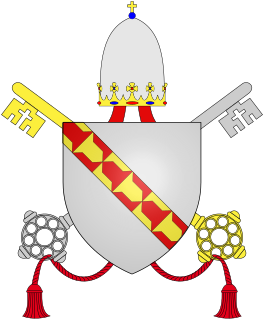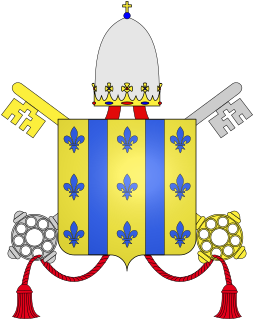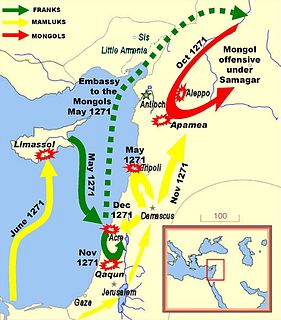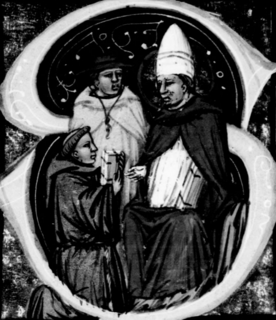
Pope Martin IV, born Simon de Brion, was the head of the Catholic Church and ruler of the Papal States from 22 February 1281 to his death. He was the last French pope to have held court in Rome; all subsequent French popes held court in Avignon.

Pope Clement V, born Raymond Bertrand de Got, was head of the Catholic Church and ruler of the Papal States from 5 June 1305 to his death in April 1314. He is remembered for suppressing the order of the Knights Templar and allowing the execution of many of its members. Pope Clement V was the pope who moved the Papacy from Rome to Avignon, ushering in the period known as the Avignon Papacy.

Pope Gregory X, born Teobaldo Visconti, was head of the Catholic Church and ruler of the Papal States from 1 September 1271 to his death and was a member of the Secular Franciscan Order. He was elected at the conclusion of a papal election that ran from 1268 to 1271, the longest papal election in the history of the Catholic Church.

Pope Innocent V, born Pierre de Tarentaise, was head of the Catholic Church and ruler of the Papal States from 21 January to 22 June 1276. A member of the Order of Preachers, he acquired a reputation as an effective preacher. He held one of the two "Dominican Chairs" at the university of Paris, and was instrumental in helping with drawing up the "program of studies" for the Order. In 1269, Peter of Tarentaise was Provincial of the French Province of Dominicans. He was a close collaborator of Pope Gregory X, who named him Bishop of Ostia and raised him to cardinal in 1273.

Pope Nicholas IV, born Girolamo Masci, was head of the Catholic Church and ruler of the Papal States from 22 February 1288 to his death. He was the first Franciscan to be elected pope.

The Eighth Crusade was the second Crusade launched by Louis IX of France, this one against the Hafsid dynasty in Tunisia in 1270. It is also known as the Crusade of Louis IX against Tunis or the Second Crusade of Louis. The Crusade did not see any significant fighting as King Louis died of dysentery shortly after arriving on the shores of Tunisia. The Treaty of Tunis was negotiated between the Crusaders and the Hafsids. No changes in territory occurred, though there were commercial and some political rights granted to the Christians. The latter withdrew back to Europe soon after.
The First Crusade inspired the crusading movement, which became an important part of late medieval western culture. The movement influenced the Church, politics, the economy, society and created a distinct ideology that described, regulated, and promoted crusading. It was defined by legal and theological terms based on the concepts of holy war and pilgrimage. Theologically, this merged ideas from Old Testament parallels of Israelite wars instigated and assisted by God, with the New Testament ideas of forming personal relationships with Christ. The concept of crusading as holy war was based on the ancient idea of just war. An authority must initiate the war, there should be just cause, and that the war should be waged with pure intention. Crusades were seen as special pilgrimages—a physical and spiritual journey under the authority and protection of the Church. Pilgrimage and crusade were penitential acts and Crusade participants were considered part of Christ's army. While this was only metaphorical before the First Crusade, the concept transferred from the clerical world to the secular. Crusaders attached crosses of cloth to their clothing marking them as followers and devotees of Christ, responding to the biblical passage in Luke 9:23 to carry one's cross and follow Christ. This formed a personal relationship formed between the participant and God that marked the participant's spirituality. Anyone could be involved and those who died campaigning were considered martyrs.

Lord Edward's crusade, sometimes called the Ninth Crusade, was a military expedition to the Holy Land under the command of Edward, Duke of Gascony in 1271–1272. It was an extension of the Eighth Crusade and was the last of the Crusades to reach the Holy Land before the fall of Acre in 1291 brought an end to the permanent crusader presence there.

The Second Council of Lyon was the fourteenth ecumenical council of the Roman Catholic Church, convoked on 31 March 1272 and convened in Lyon, Kingdom of Arles, in 1274. Pope Gregory X presided over the council, called to act on a pledge by Byzantine emperor Michael VIII to reunite the Eastern church with the West. The council was attended by about 300 bishops, 60 abbots and more than a thousand prelates or their procurators, among whom were the representatives of the universities. Due to the great number of attendees, those who had come to Lyon without being specifically summoned were given "leave to depart with the blessing of God" and of the Pope. Among others who attended the council were James I of Aragon, the ambassador of the Emperor Michael VIII Palaiologos with members of the Greek clergy and the ambassadors of Abaqa Khan of the Ilkhanate. Thomas Aquinas had been summoned to the council, but died en route at Fossanova Abbey. Bonaventure was present at the first four sessions, but died at Lyon on 15 July 1274. As at the First Council of Lyon, Thomas Cantilupe was an English attendee and a papal chaplain.
Maria of Antioch was a claimant to the throne of the Kingdom of Jerusalem from 1268 to 1277. In 1267 she laid claim to govern the kingdom as regent in the name of the absentee King Conrad III. Her legal case was solid, resting on the proximity of blood to the king, but she was rejected by the High Court of Jerusalem in favor of Hugh III of Cyprus. When Conrad died in 1268, she demanded to be crowned as his successor. Spurned yet again for Hugh, she moved to Europe and eventually sold her claim to Charles I of Anjou.

The siege of Acre took place in 1291 and resulted in the Crusaders losing control of Acre to the Mamluks. It is considered one of the most important battles of the period. Although the crusading movement continued for several more centuries, the capture of the city marked the end of further crusades to the Levant. When Acre fell, the Crusaders lost their last major stronghold of the Crusader Kingdom of Jerusalem. They still maintained a fortress at the northern city of Tartus, engaged in some coastal raids, and attempted an incursion from the tiny island of Ruad, but when they lost that as well in 1302 in the siege of Ruad, the Crusaders no longer controlled any part of the Holy Land.
The Crusades were a series of religious wars initiated, supported, and sometimes directed by the Latin Church in the medieval period. The best known of these Crusades are those to the Holy Land in the period between 1095 and 1291 that were intended to recover Jerusalem and its surrounding area from Islamic rule. Beginning with the First Crusade, which resulted in the recovery of Jerusalem in 1099, dozens of Crusades were fought, providing a focal point of European history for centuries.

Several attempts at a Franco-Mongol alliance against the Islamic caliphates, their common enemy, were made by various leaders among the Frankish Crusaders and the Mongol Empire in the 13th century. Such an alliance might have seemed an obvious choice: the Mongols were already sympathetic to Christianity, given the presence of many influential Nestorian Christians in the Mongol court. The Franks were open to the idea of support from the East, in part owing to the long-running legend of the mythical Prester John, an Eastern king in an Eastern kingdom who many believed would one day come to the assistance of the Crusaders in the Holy Land. The Franks and Mongols also shared a common enemy in the Muslims. However, despite many messages, gifts, and emissaries over the course of several decades, the often-proposed alliance never came to fruition.

The historiography of the Crusades is the study of history-writing and the written history, especially as an academic discipline, regarding the military expeditions initially undertaken by European Christians in the 11th, 12th, or 13th centuries to the Holy Land. This scope was later this extended to include other campaigns initiated, supported, and sometimes directed by the Roman Catholic Church. The subject has involved competing and evolving interpretations since the capture of Jerusalem in 1099 until the present day. The religious idealism, use of martial force and pragmatic compromises made by those involved in crusading were controversial, both at the time and subsequently. Crusading was integral to Western European culture, with the ideas that shaped behaviour in the Late Middle Ages retaining currency beyond the 15th century in attitude rather than action.

The Eastern Roman (Byzantine) imperial church headed by Constantinople continued to assert its universal authority. By the 13th century this assertion was becoming increasingly irrelevant as the Eastern Roman Empire shrank and the Ottoman Turks took over most of what was left of the Byzantine Empire. The other Eastern European churches in communion with Constantinople were not part of its empire and were increasingly acting independently, achieving autocephalous status and only nominally acknowledging Constantinople's standing in the Church hierarchy. In Western Europe the Holy Roman Empire fragmented making it less of an empire as well.

The Barons' Crusade (1239–1241), also called the Crusade of 1239, was a crusade to the Holy Land that, in territorial terms, was the most successful crusade since the First Crusade. Called by Pope Gregory IX, the Barons' Crusade broadly embodied the highest point of papal endeavor "to make crusading a universal Christian undertaking." Gregory IX called for a crusade in France, England, and Hungary with different degrees of success. Although the crusaders did not achieve any glorious military victories, they used diplomacy to successfully play the two warring factions of the Ayyubid dynasty against one another for even more concessions than Frederick II had gained during the more well-known Sixth Crusade. For a few years, the Barons' Crusade returned the Kingdom of Jerusalem to its largest size since 1187.
The Crusade of the Poor was an unauthorised military expedition—one of the so-called "popular crusades"—undertaken in the spring and summer of 1309 by members of the lower classes from England, Flanders, Brabant, northern France and the German Rhineland. Responding to an appeal for support for a crusade to the Holy Land, the men, overwhelmingly poor, marched to join a small professional army being assembled with Papal approval. Along the way, they engaged in looting, persecution of Jews and combat with local authorities. None of them reached the Holy Land and their expedition was ultimately dispersed.

Fidentius of Padua was a Franciscan administrator and writer active in the Holy Land between 1266 and 1291. He wrote a tract on the Christian recovery and retention of the Holy Land.